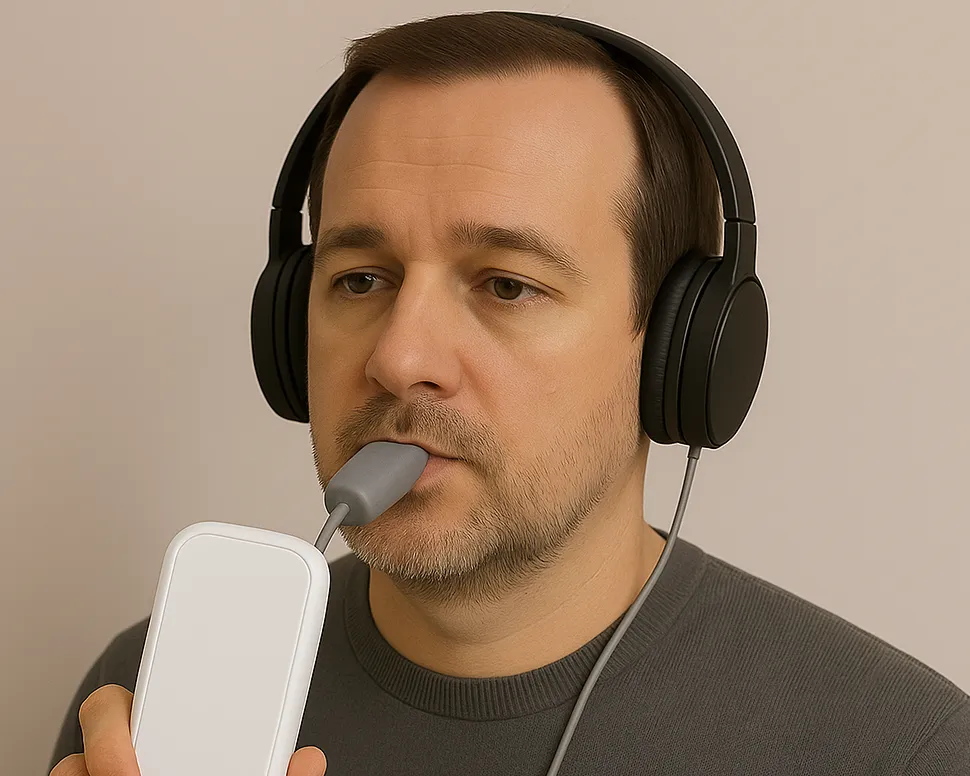
New Research on Lenire- Ready for Prime Time?
I’ve written previously about the Lenire bimodal neuromodulation device that received FDA approval for the treatment of tinnitus in 2023. I’ve been somewhat critical of the research that was published regarding the effectiveness of this device prior to the FDA approval. Specifically, I was surprised that the FDA would approve a device of this nature designed to treat a subjective condition like tinnitus without a placebo-controlled study showing significant clinical benefit. As such, I’ve also been rather reluctant to recommend this expensive device to my patients suffering with tinnitus.
This blog post is an update on the clinical evidence supporting the Lenire device following the publication of another (finally “controlled”) prospective clinical study, called TENT-A3, that appeared in Nature Communications at the end of 2024
This is the third published clinical research study for Lenire, a bimodal neuromodulation device developed by NeuroMod to treat tinnitus. This device is designed to deliver mild electrical pulses to the tongue combined with sound played through headphones to drive neuroplastic changes in the brain aimed at reducing tinnitus.
Unlike the prior two studies, this study was designed to include a “control” group, though this was a single arm study in which each participant served as their own control. This is very different from a double blind randomized controlled trial which is really the preferred standard for clinical research. The authors of the study claimed that a blinded randomized controlled study was not possible because both the sound and tongue stimulation used in Lenire involve interactions that subjects can feel so they could not deliver a “sham” condition without such stimulation because the participants would know. I don’t agree with this assertion because new participants would not really know how the device “is supposed to feel”. They could even have used some totally different character or pattern of nonsynchronized or random sound and tongue stimulation as a control condition to verify that their specific model of binomodal neuromodulation was actually doing something novel. Anyway, they report that this single arm design was created with the input of the FDA. Each participant served as their own control. Participants’ tinnitus severity was measured at the beginning of the study, then they received six weeks of just the sound portion of their treatment protocol (without the tongue stimulation). Then the tinnitus severity was measured again. Then each participant received six more weeks of the bimodal stimulation, including both the sound and the tongue stimulation. Then the tinnitus severity was measured a third time. The primary endpoint being evaluated was the Tinnitus Handicap Inventory (THI), a validated survey tool that measures how much tinnitus negatively affects a person's life. The Tinnitus Functional Index and quality of life measurements were also measured as secondary endpoints. Their goal was to demonstrate that a higher percentage of participants would show a meaningful additional improvement in THI during the second six weeks (receiving the full bimodal stimulation) than during the first six weeks (receiving just the sound input).
Key Results:
When incorporating the data from all the participants, the researchers did not meet their outcome goal of demonstrating a higher rate of treatment response (defined as an improvement of at least seven points on the THI scale- a common threshold for what is considered clinically significant improvement in tinnitus) during the second six weeks of the study compared to the first six weeks. This does not mean that the trial was a failure, however.
They observed that 63.3% of subjects met the criteria for successful treatment response (improvement of at least seven points on the THI scale) after the first 6 weeks of the study in which the participants only received the sound portion of the protocol without the tongue stimulation. I suspect this was a higher response rate than they expected at this stage. Following the second six weeks of the study, during which they combined the sound input and tongue stimulation, 43.3% of participants showed an additional improvement in their THI scores of at least seven points. This represents meaningful improvement in tinnitus severity. However, since the 43.3% stage 2 response rate was lower than the 63.3% stage 1 response rate, they had to admit that they did not meet their planned outcome goal set during the study design.
At the end of the 12 week study, 79.4% of the study participants reported a reduction in their THI score of at least seven points.
Despite the surprisingly high response rate to the sound-only treatment in stage 1 of the study, the researchers observed that 64.9% of participants who did not see meaningful improvements after stage 1 subsequently experienced a clinically significant improvement in their tinnitus with the bimodal treatment in stage 2.
Subgroup analysis suggests that patients with greater tinnitus severity (THI>38) may benefit more from the bimodal neuromodulation than those with less severe tinnitus.
The treatment showed very high satisfaction rates: 88.6% of subjects would recommend Lenire to others suffering with tinnitus
A significant percentage of participants reported worsened tinnitus at some point during the study (36% during stage 1, 11% during stage 2), though the researchers suggest that almost all of these exacerbations were temporary. Other than worsened tinnitus, adverse events were rare during the study.
The researchers did not reveal any data about the average improvement in THI among the entire group of subjects participating in the study. They only report the THI change for the subgroup of patients that were identified as better responders. Most of the data from the study is reported as “response rates”. The omission of this THI data, which is reported in most tinnitus treatment studies, makes me suspicious. I extrapolated the data from Figure 2 in their paper to calculate the average THI improvement among the better responding group (the forty subjects with THI>38 at the onset of the study) and the result was 15 points. This is presumably a larger average THI improvement than we would see if we included the data from the entire study group of 112 subjects. Even if we ignore that fact: A fifteen point average improvement in THI is respectable, but we have seen greater average improvements in THI from studies of cognitive behavioral therapy and mindfulness interventions.
Take Home Points:
The TENT-A3 study provides more robust clinical evidence that the Lenire device can provide meaningful improvements in tinnitus severity in many patients, especially those with more severe tinnitus. However, this treatment is not the powerful cure for tinnitus that many had hoped. I suspect that if the full data set was published, we would observe that most subjects observed THI improvements in the 5-15 point range, which is no better than currently available therapies. It’s also hard to ignore the fact that a significant percentage of users reported a worsening of their tinnitus at some point during the treatment. For these reasons, I still consider Lenire to be a second-line therapy for tinnitus that is best reserved for patients that do not find meaningful improvement with more affordable and lower risk interventions like mindfulness based cognitive therapy, sound therapy, sleep optimization, stress reduction, cognitive behavioral therapy, and favorable lifestyle changes.



